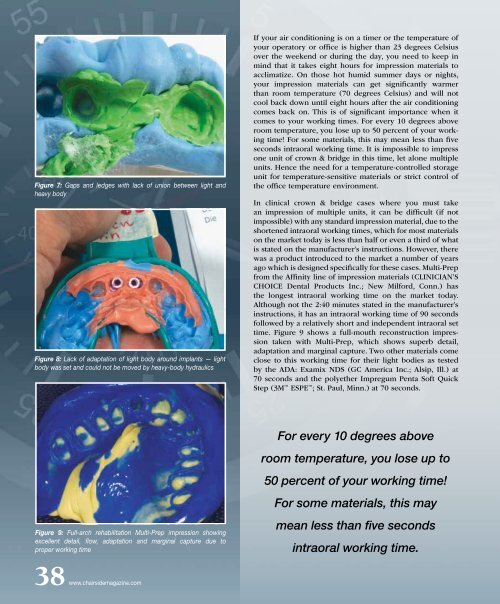Chairside - Glidewell Dental Labs
Chairside - Glidewell Dental Labs
Chairside - Glidewell Dental Labs
You also want an ePaper? Increase the reach of your titles
YUMPU automatically turns print PDFs into web optimized ePapers that Google loves.
Figure 7: Gaps and ledges with lack of union between light and<br />
heavy body<br />
Figure 8: Lack of adaptation of light body around implants — light<br />
body was set and could not be moved by heavy-body hydraulics<br />
If your air conditioning is on a timer or the temperature of<br />
your operatory or office is higher than 23 degrees Celsius<br />
over the weekend or during the day, you need to keep in<br />
mind that it takes eight hours for impression materials to<br />
acclimatize. On those hot humid summer days or nights,<br />
your impression materials can get significantly warmer<br />
than room temperature (70 degrees Celsius) and will not<br />
cool back down until eight hours after the air conditioning<br />
comes back on. This is of significant importance when it<br />
comes to your working times. For every 10 degrees above<br />
room temperature, you lose up to 50 percent of your working<br />
time! For some materials, this may mean less than five<br />
seconds intraoral working time. It is impossible to impress<br />
one unit of crown & bridge in this time, let alone multiple<br />
units. Hence the need for a temperature-controlled storage<br />
unit for temperature-sensitive materials or strict control of<br />
the office temperature environment.<br />
In clinical crown & bridge cases where you must take<br />
an impression of multiple units, it can be difficult (if not<br />
impossible) with any standard impression material, due to the<br />
shortened intraoral working times, which for most materials<br />
on the market today is less than half or even a third of what<br />
is stated on the manufacturer’s instructions. However, there<br />
was a product introduced to the market a number of years<br />
ago which is designed specifically for these cases. Multi-Prep<br />
from the Affinity line of impression materials (CLINICIAN’S<br />
CHOICE <strong>Dental</strong> Products Inc.; New Milford, Conn.) has<br />
the longest intraoral working time on the market today.<br />
Although not the 2:40 minutes stated in the manufacturer’s<br />
instructions, it has an intraoral working time of 90 seconds<br />
followed by a relatively short and independent intraoral set<br />
time. Figure 9 shows a full-mouth reconstruction impression<br />
taken with Multi-Prep, which shows superb detail,<br />
adaptation and marginal capture. Two other materials come<br />
close to this working time for their light bodies as tested<br />
by the ADA: Examix NDS (GC America Inc.; Alsip, Ill.) at<br />
70 seconds and the polyether Impregum Penta Soft Quick<br />
Step (3M ESPE ; St. Paul, Minn.) at 70 seconds.<br />
For every 10 degrees above<br />
room temperature, you lose up to<br />
50 percent of your working time!<br />
For some materials, this may<br />
Figure 9: Full-arch rehabilitation Multi-Prep impression showing<br />
excellent detail, flow, adaptation and marginal capture due to<br />
proper working time<br />
mean less than five seconds<br />
intraoral working time.<br />
38 www.chairsidemagazine.com
















